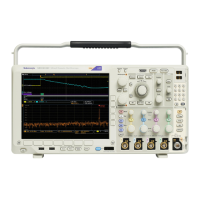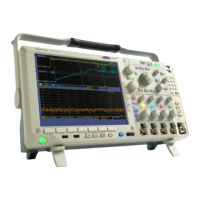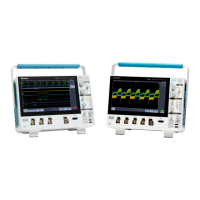Commands Listed in Alphabetical Order
Syntax
BUS:LOWerthre
shold:REF<x> {<NR3>|ECL|TTL}
BUS:LOWerthreshold:REF<x>?
Related Commands
BUS:UPPerthreshold:REF<x>
Arguments
<NR3> is a floating point number that specifies the lower threshold for the
reference waveform, in volts
ECL – ECL (-1.3 volts). Note that this setting is constrained, depending upon the
vertical scale for the specified reference waveform.
TTL – TTL (1.4 volts). Note that this setting is constrained, depending upon the
vertical scale for the specified reference waveform.
Examples
BUS:LOWerthreshold:REF2 TTL sets the lower threshold for reference
waveform 2 to 1.4 volts. Note that this setting is constrained, depending upon the
vertical scale for the specified reference waveform.
BUS:LOWerthreshold:REF3? might return 0.0E+0, which is the default.
BUS:THReshold:CH<x>
This command specifies the threshold for analog channel <x>, where x is the
channel number (1–4). This setting applies to all trigger types that use the channel.
Conditions
This command requires a serial bus analysis module on DPO models.
Group
Bus
Syntax
BUS:THReshold:CH<x> {ECL|TTL|<NR3>}
BUS:THReshold:CH<x>?
Arguments
ECL specifies a preset ECL high level of –1.3V.
TTL specifies a TTL preset high level of 1.4V.
<NR3> is a floating point number that specifies the threshold level, in volts.
BUS:THReshold:D<x>
This command specifies the threshold for digital channel <x>, where x is the
digital channel number (0–15). This will apply to all Search and Trigger Types
that use the channel.
2-206 MDO4000/B/C, MSO/DPO4000B and MDO3000 Series Oscilloscopes Programmer Manual

